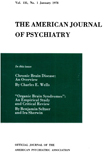ADDICTIVE ASPECTS IN HEAVY CIGARETTE SMOKING
Abstract
1. Fifteen heavy smokers were observed in a state of sudden abstinence, and contrasted with a comparable group of 11 subjects allowed to smoke ad libitum. Cardiac slowing, presumably vagotonic, and a lowering of diastolic blood pressure was found in the experimental group. Other less clear-cut complaints of distress, such as "emptiness," and slow passage of time, seemed related to the state of abstinence. The cardiovascular findings were replicated in a group switched under controlled, singleblind conditions from high nicotine to low nicotine cigarettes.
2. Heavy cigarette smokers thus appear to be true addicts, showing not only social habituation but mild physiologic withdrawal effects.
3. It would appear that the opposite of vagotonic action, namely chronic sympathetic stimulation, is one result of heavy smoking.
4. With appropriate motivation very heavy smoking can be given up, though just as readily resumed. Concerns about the dangers of smoking, latent but readily mobilized in our population, are effectively masked by denial and related psychic defences. They must be unmasked to understand and treat heavy smoking, if treatment is desired.
5. Clinically, smoking appears to represent a complex learned psychosomatic pattern. Primary pleasure from the habit occurs but appears to become subordinate to secondary use of it to ward off pain, especially anxiety or a sense of loss. Various aspects or layers contribute to the urge: a) the symbolic and personal meaning of smoking to the smoker; b) the numerous sensations accompanying smoking–gustatory, pulmonary, tactile, visual and kinesthetic; c) the impulse to take in and eliminate, interwoven with but not identical with alimentary urges; d) the seeking in heavy smokers of a state of chronic low-grade arousal.
6. Our hypothesis is that the motor act of smoking contributes to the relaxing aspects of the habit, whereas, in compromise, sympathetic nervous arousal is mediated pharmacologically by nicotine.
Access content
To read the fulltext, please use one of the options below to sign in or purchase access.- Personal login
- Institutional Login
- Sign in via OpenAthens
- Register for access
-
Please login/register if you wish to pair your device and check access availability.
Not a subscriber?
PsychiatryOnline subscription options offer access to the DSM-5 library, books, journals, CME, and patient resources. This all-in-one virtual library provides psychiatrists and mental health professionals with key resources for diagnosis, treatment, research, and professional development.
Need more help? PsychiatryOnline Customer Service may be reached by emailing [email protected] or by calling 800-368-5777 (in the U.S.) or 703-907-7322 (outside the U.S.).



